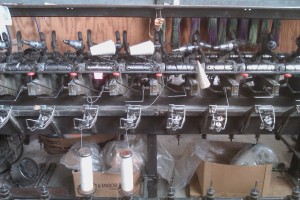Sun 21 Nov 2010
One of my friends from the spinning guild just happens to own a small-scale woolen mill, and yesterday was their fall open house. We went down to take a look, and Branden took a few photos on his phone, as we both managed to forget to bring a camera.
The wool is washed, picked (to open up the locks), and then fed into the machine for carding. Here it is, waiting to drop into the carding drums.
It passes through a long series of drums, getting more and more finely carded along the way.
The center drum is taller than I am, to give you a sense of scale.
At the end of the first carding series, the wool is bundled into roving by gathering it all together and drafting gently.
Then that roving is laid out and fed into a second set of finer cards (this helps it to become a completely uniform thickness).
At the end of the second set of cards, it gets run through a series of little grooves, which turn the batt of fiber…
…into 60 separate threads of extremely fine pencil roving. This gets wound onto a big roll for spinning.
Here’s a close up of that pencil roving coming of the machine.
And here are a few rolls waiting to be spun.
Next, the rolls are put on the spinner. One roll goes on the top of the machine, and all 60 of those ends get threaded down to the holding bobbins (at the very bottom of the picture), which are constantly spinning.
The singles can be wound onto cones,
Or they can be plied using another complicated machine that we didn’t get a picture of.
Then, finally, all of the bobbins are lined up, and wrapped onto a barrel frame to make skeins.
Wool mills like this are apparently pretty rare, so we were lucky to get a chance to see inside. Most of the equipment is more than a hundred years old, and was bought at scrap metal prices when a mill in Massachusetts was closing down. It’s been running here for 22 years now, and they say that it’s still going strong. Every other year, the owners drive out to North Carolina, where another farmer raises the wool that they use to make their yarn (I think it was 500 sheep’s worth). Then, they haul it all down to Texas to go through the one and only scouring plant left in the country. After washing, it’s shipped to Wisconsin, where it goes through these machines and becomes the wool that we buy. Every skein is hand-dyed, in batches of about 10 at a time. It’s a pretty amazing process, and they make some pretty amazing yarn. I’ll show you some of that when we’ve had some sunlight to take pictures.












Very cool! Thanks to your friends for sharing with you and to you for sharing with us.
That’s so interesting! Thank you for taking us along!
How neat! I always love seeing those sorts of behind-the-scenes tours. Thanks to working in architecture, I’ve gotten to see some really neat things–probably the best was seeing potato chips being made!
Thanks for sharing.
It seems to me that you know a lot about knitting, and also about yarn! Therefore I’m asking you, do you know if there exist any really fat yarn? Like really fat? I would like to try to knit one of these: http://marit85.wordpress.com/2010/11/24/i-want-an-urchin-puff-from-these-flocks/
Lots of great inspiration here at your blog btw;)
Oh, so much lovely fiber! And machines! I think I should have been a small scale spinner instead of a chemical engineer. Thanks for the fun!